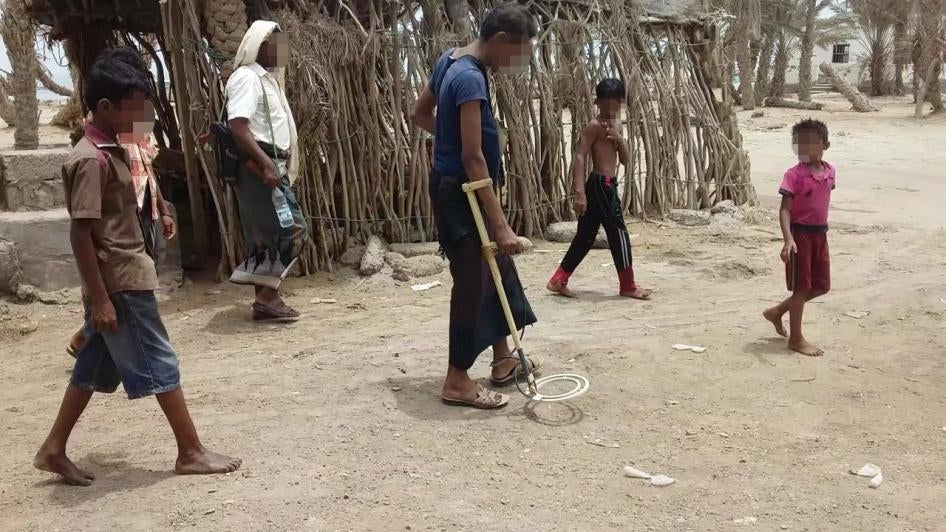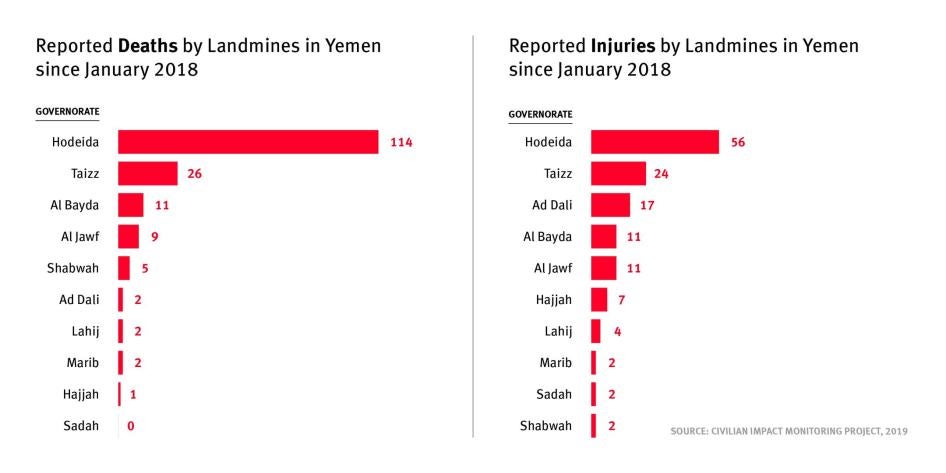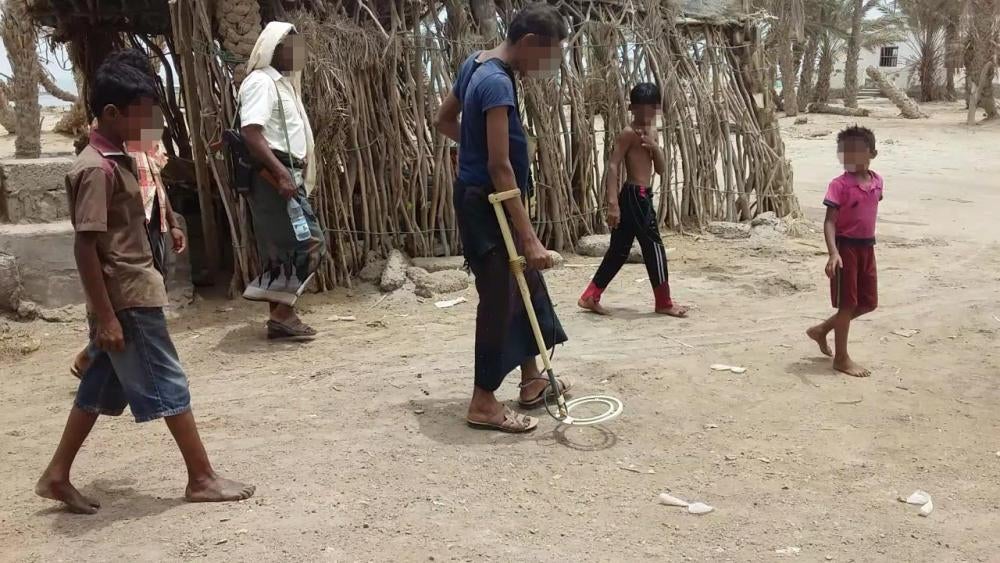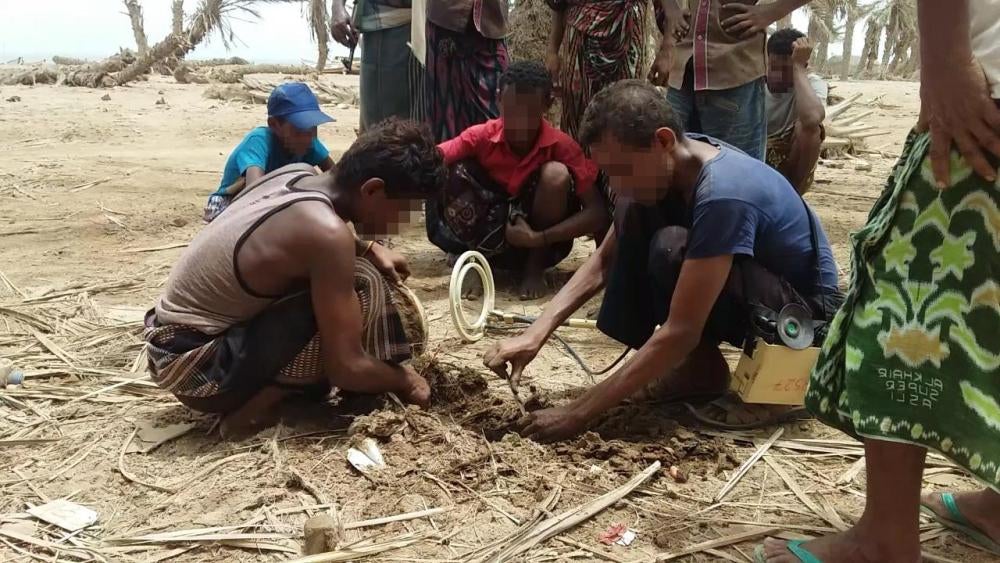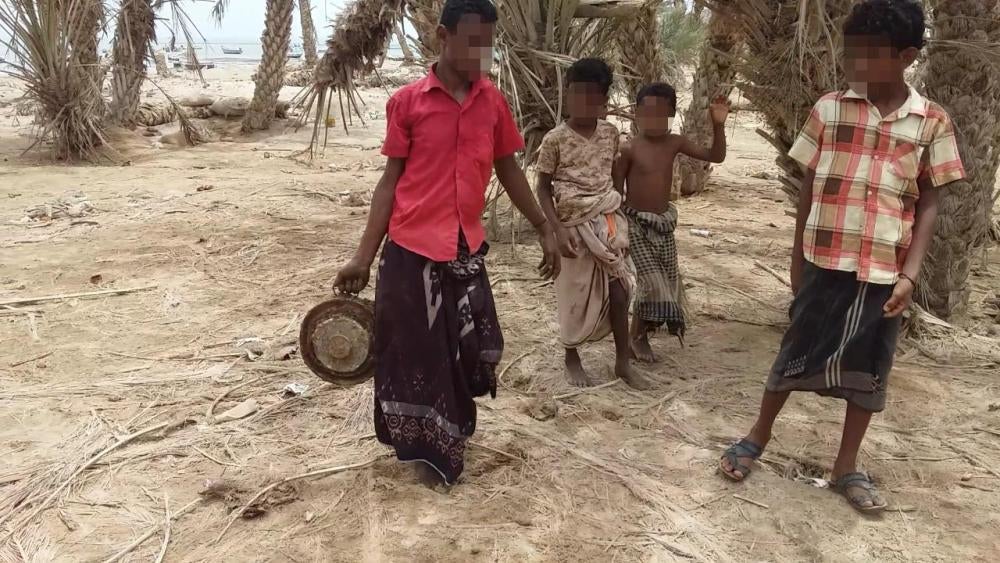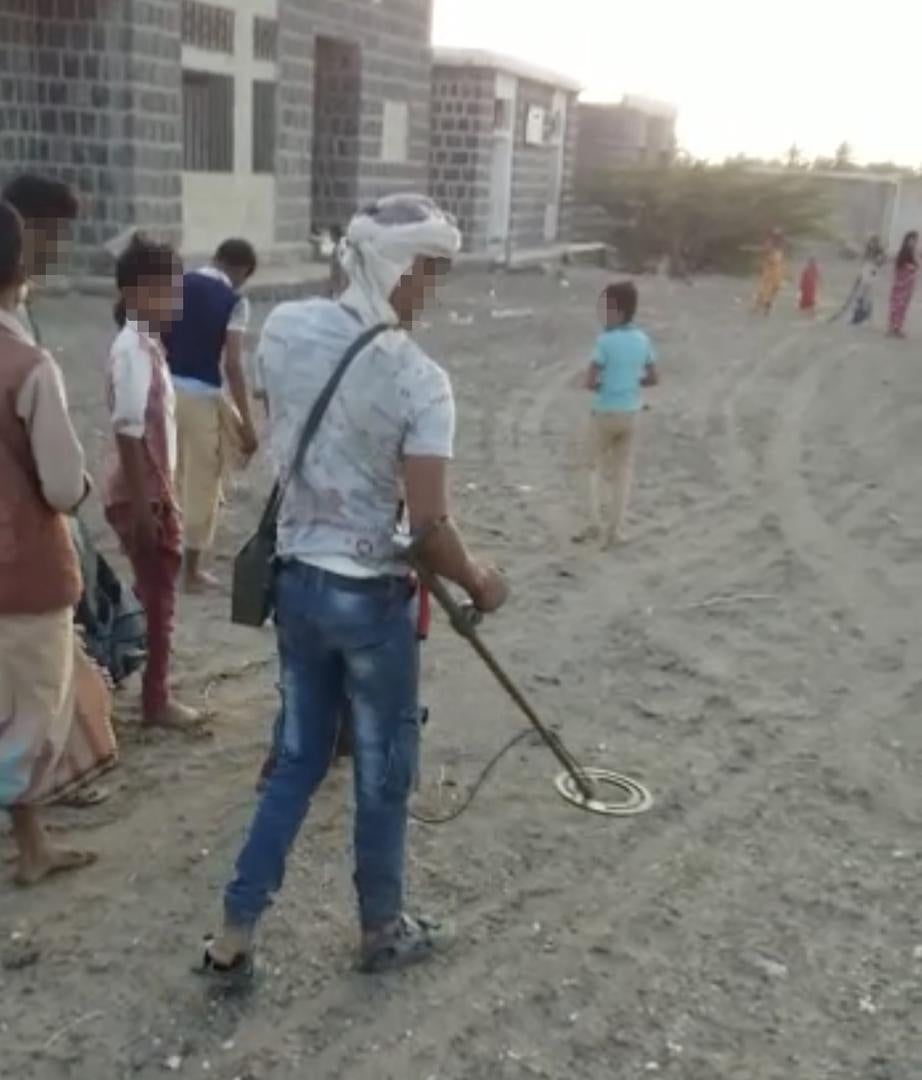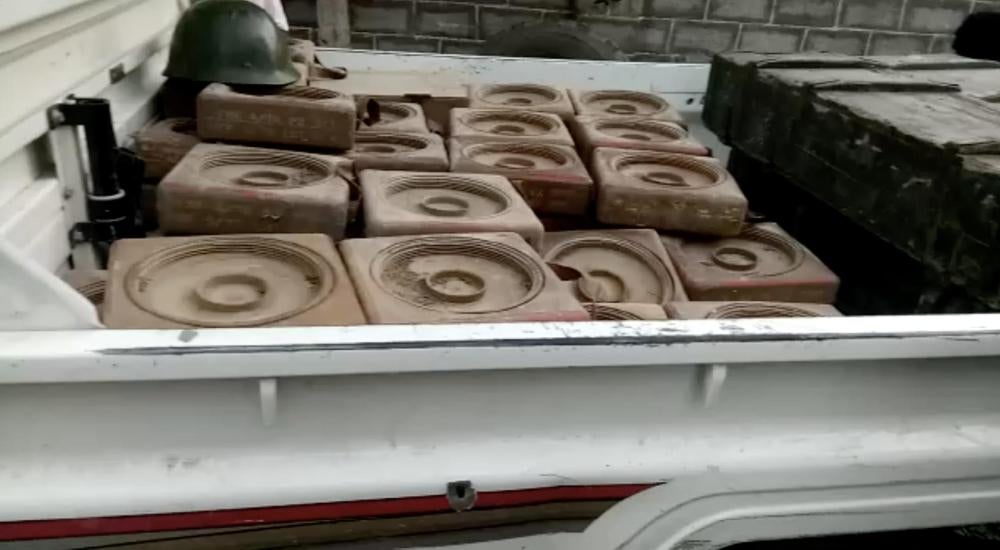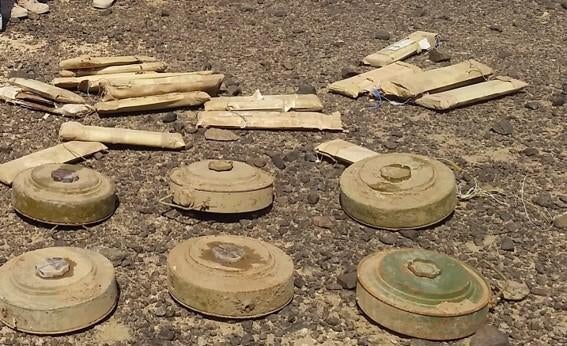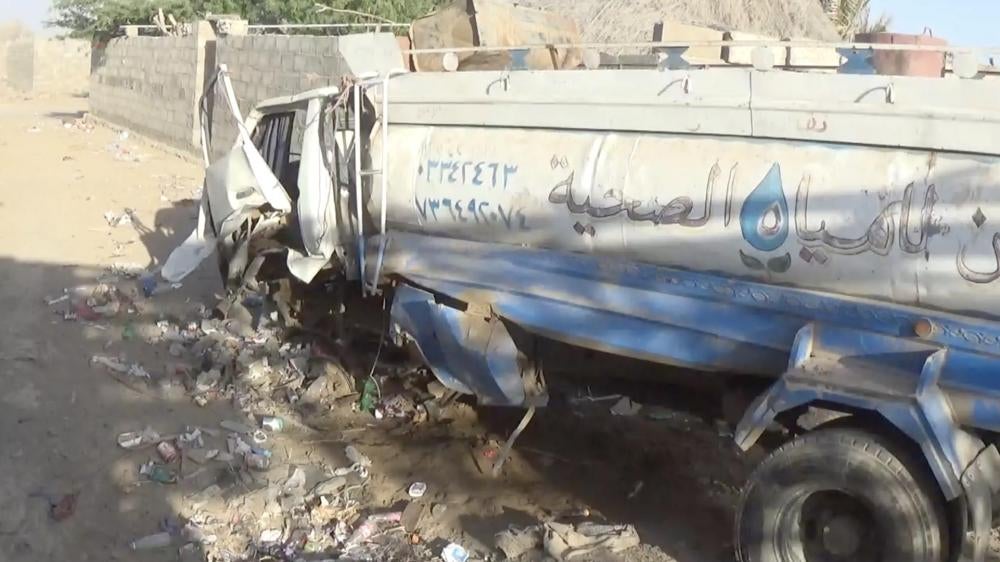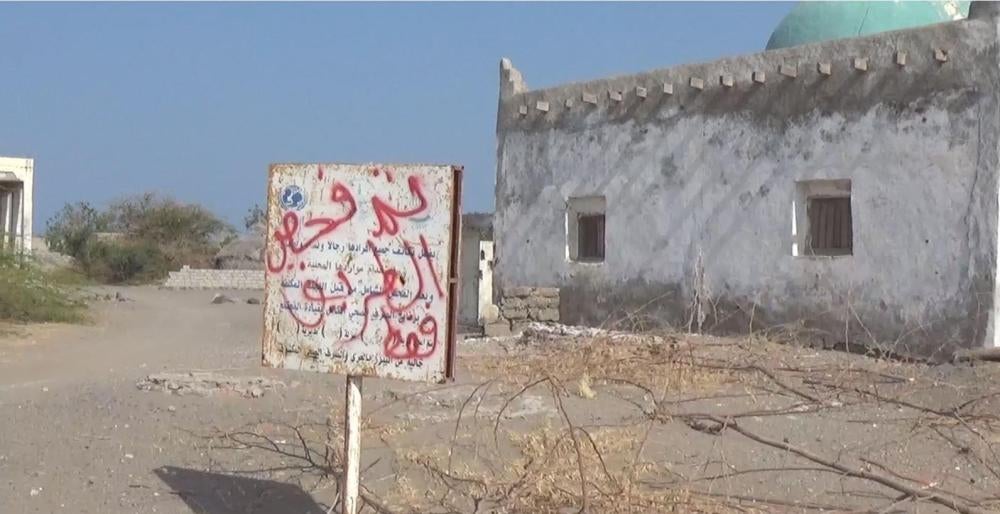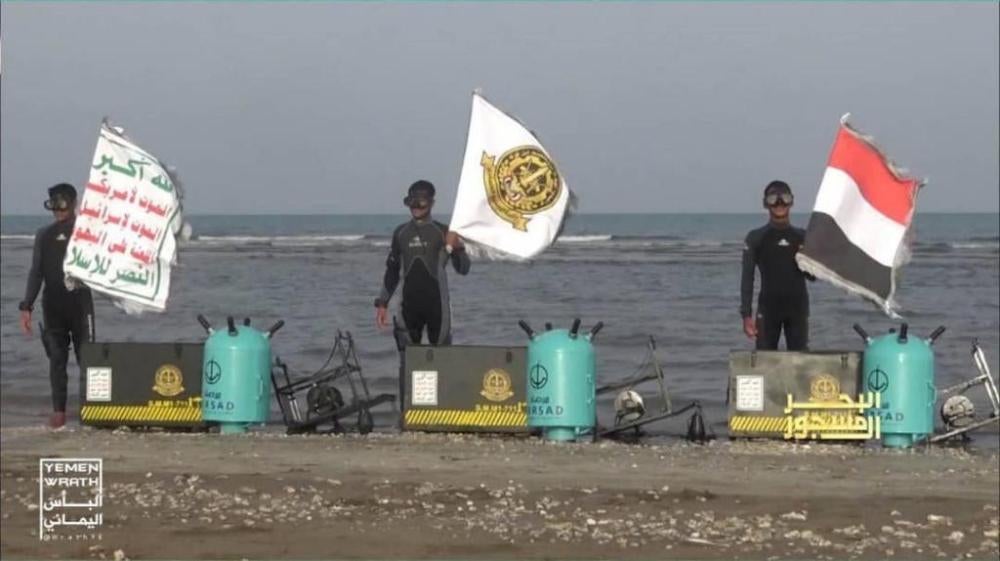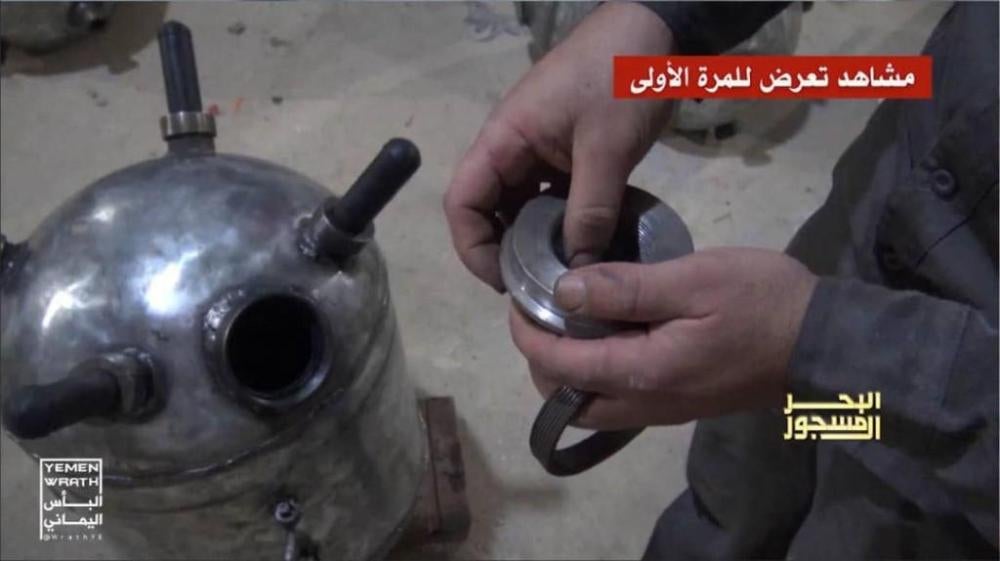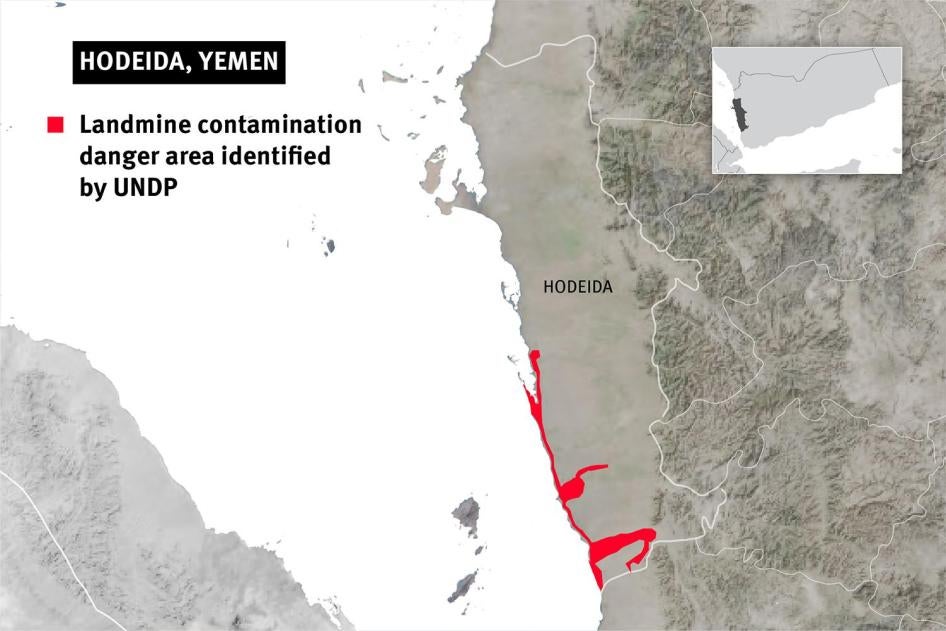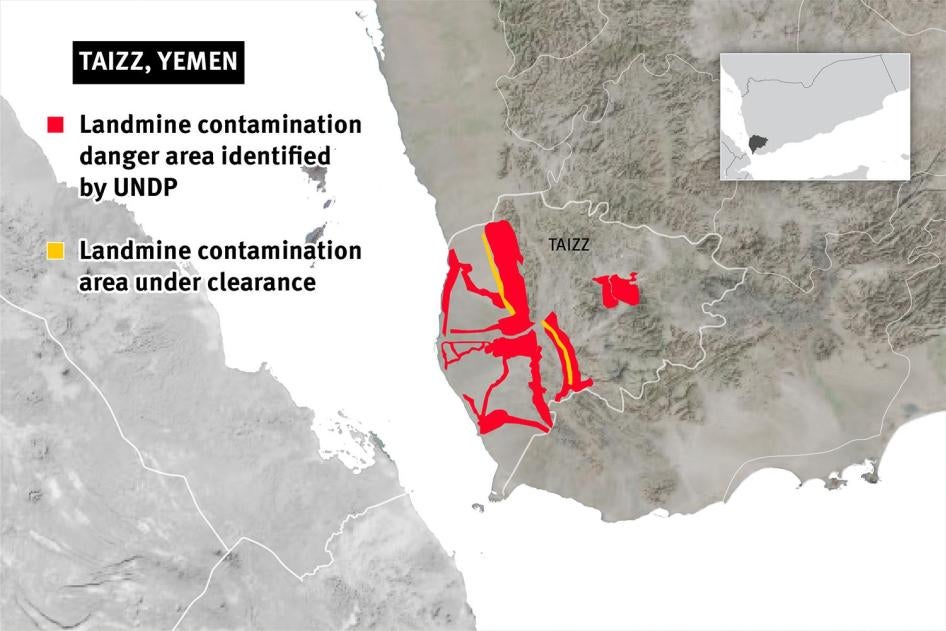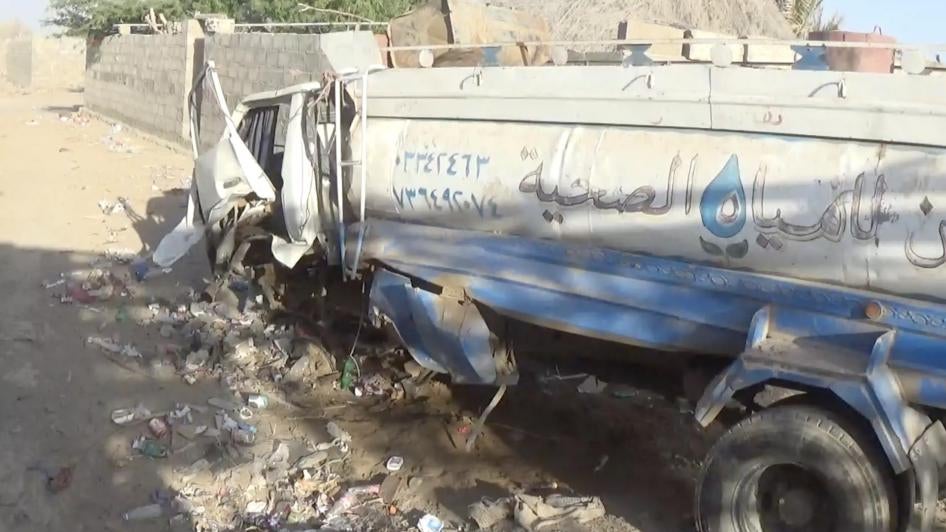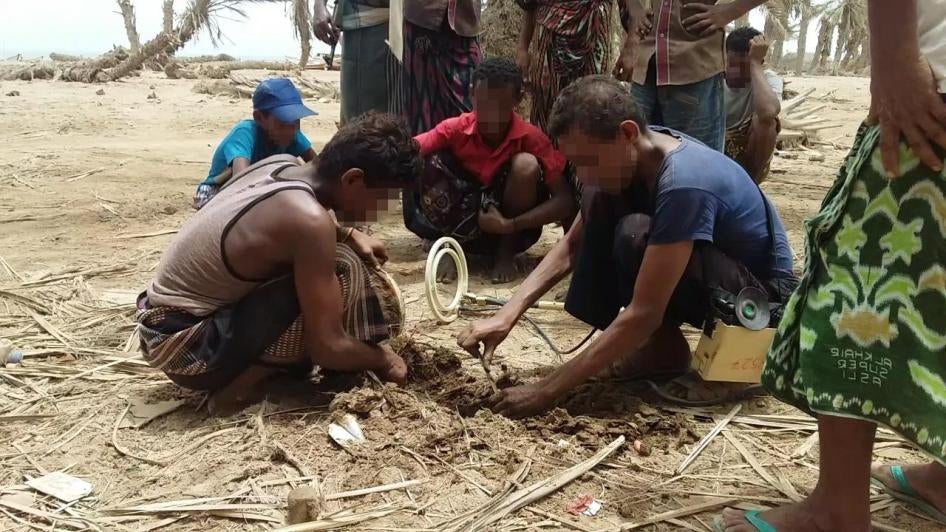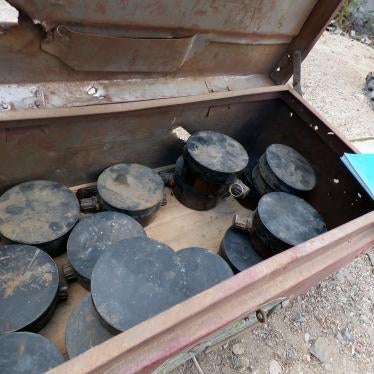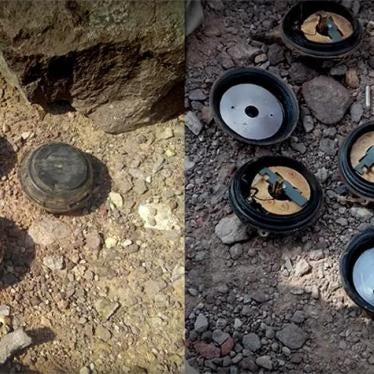(Beirut) – Houthi forces’ widespread use of landmines along Yemen’s western coast since mid-2017 has killed and injured hundreds of civilians and prevented aid groups from reaching vulnerable communities, Human Rights Watch said today. Yemeni law and the 1997 Mine Ban Treaty ban all use of antipersonnel mines; anti-vehicle mines have been used indiscriminately in violation of the laws of war, posing dangers to civilians long after hostilities have ceased.
Landmines laid in farmlands, villages, wells, and roads have killed at least 140 civilians, including 19 children, in the Hodeida and Taizz governorates since 2018, according to the Civilian Impact Monitoring Project, a humanitarian data source. Landmines and improvised explosive devices (IEDs) have prevented humanitarian organizations from reaching populations in need, left farms and wells inaccessible, and harmed civilians trying to return home.
“Houthi-laid landmines have not only killed and maimed numerous civilians, but they have prevented vulnerable Yemenis from harvesting crops and drawing clean water desperately needed for survival,” said Priyanka Motaparthy, acting emergencies director at Human Rights Watch. “Mines have also prevented aid groups from bringing food and health care to increasingly hungry and ill Yemeni civilians.”
Human Rights Watch researchers visited the southern port city of Aden in February 2019 and interviewed civilians injured by landmines as well as civilians fleeing mined areas, aid workers, and a deminer from Yemen Executive Mine Action Centre; analyzed video and photographs collected in country; and reviewed Houthi state and military media channels.
Human Rights Watch found evidence that in addition to laying anti-personnel landmines, Houthi forces planted anti-vehicle mines in civilian areas, modified anti-vehicle mines to detonate from a person’s weight, and disguised improvised explosive devices as rocks or parts of tree trunks. Human Rights Watch also found that the Houthis have used antipersonnel mines in Hayran, near the Saudi Arabia border, and confirmed their use of naval mines despite the risk to commercial, fishing, and aid vessels.
Victims and witnesses told Human Rights Watch that the areas where landmines caused deaths and injuries were previously controlled by Houthi forces and that civilians had not been harmed until the Houthi withdrawal, when the mines presumably were planted. A 25-year-old man displaced from Nakhil village in Tuhayta district said that Houthis laid mines in his village around May 2018: “[The Houthis] warned me and said, ‘Don’t enter this area, we’re mining it.’ They told me that the area was mined.”
Landmines have also left at least three western coast water facilities inaccessible, two aid groups said. In addition, mines have made it more difficult for villagers to feed themselves and maintain their income. Five people said that they had been injured or that relatives had been killed when landmines detonated in farmlands or grazing lands; many displaced people said mines prevented safe harvesting and killed valuable livestock.
Landmines have prevented humanitarian organizations from reaching communities in need along the western coast, Human Rights Watch said. These included villages and towns in the Tuhayta and Mawza’a districts, as well as the major port city of Hodeida. Three aid groups said they could not reach key places or provide services to areas because landmines were planted there or along the route. Many of these communities are only accessible by dirt roads, which are far more hazardous than paved surfaces.
The Houthis’ use of landmines, which deprives people of water and food sources, contributes to the humanitarian crisis that afflicts the entire war-torn country, Human Rights Watch said. On April 9, 2019, the United Nations humanitarian coordinator, Lise Grande, described Yemen as “the worst food security crisis in the world and one of the worst cholera outbreaks in modern history.” All of the districts noted here are either at crisis or emergency levels of food insecurity, while cholera cases are on the rise in Hodeida and Taizz governorates.
Authorities in Sanaa, the Houthi-controlled capital, informed Human Rights Watch in April 2017 that they consider the 1997 Mine Ban Treaty, which Yemen ratified in 1998, to be binding. In addition to the prohibition on use in the Mine Ban Treaty, individuals responsible for using prohibited weapons or carrying out indiscriminate attacks may be prosecuted for war crimes.
The Houthi authorities should immediately cease using these weapons and credibly investigate and appropriately punish commanders responsible for their use, Human Rights Watch said. Both the UN Group of Eminent Experts and the Security Council Panel of Experts should investigate Houthi landmine use and identify individuals responsible for widespread use where possible. The Panel of Experts should investigate individuals who may be responsible for war crimes, including impeding aid indispensable for the survival of civilians.
The Security Council should impose targeted sanctions on all individuals responsible for such violations. While the Council has imposed sanctions against Houthi leaders, it has taken no steps against members of the Saudi-led coalition, which has been responsible for numerous unlawful attacks since the conflict began.
While Houthi forces bear primary responsibility for civilian casualties and foreseeable civilian harm from landmines, inadequate training for deminers and poor coordination among demining groups has contributed to the problems in heavily mined areas. Various demining groups have failed to adequately share information about the types of devices discovered and their locations.
Human Rights Watch reviewed videos of at least three mine detection and clearance operations on Yemen’s western coast that clearly did not comply with International Mine Action Standards (IMAS) and safe demining practices. Deminers are seen removing live mines while children and other apparent civilians stand nearby. Houthi official news media have treated the deaths of the pro-Hadi government deminers as victories even though even though antipersonnel mines are unlawful and anti-vehicle mines have been used indiscriminately.
All humanitarian demining organizations should share information through a coordinated response guided by the International Mine Action Standards. Shared information should include mine locations, usage, and device types to allow for better training and safer demining practices. All parties to the conflict, including the Houthis, the Yemeni government, and the Saudi and Emirati-led coalition, should facilitate demining, including by providing visas to experts and approving technical and protective equipment for deminers, Human Rights Watch said.
Yemen’s government and coalition allies should urgently improve demining efforts and increase assistance to victims of landmines, which concerned governments should support, Human Rights Watch said.
“Houthi leaders should immediately end their use of landmines, for which they may one day be held to account,” Motaparthy said. “Governments concerned about the devastating impact of landmines in Yemen should support demining efforts, including through better training and coordination, as well as victim assistance.”
Landmine Use in Yemen
Houthi and allied forces have used landmines in at least six governorates in Yemen since the Saudi Arabia and Emirati-led coalition began military operations against them in March 2015. The Durayhimi and Tuhayta districts in Hodeida governorate had by far the highest number of reported deaths from landmines in 2018, according to the Civilian Impact Monitoring Project. The data underrepresents the number of incidents, as many go unreported or are not reported as mine incidents.
The Yemen Executive Mine Action Center (YEMAC), which coordinates activity related to mines, reported that the Yemeni army cleared 300,000 mines around the country between 2016 and 2018. Human Rights Watch previously documented Houthi use of antipersonnel and anti-vehicle landmines between 2015 and 2018 in the Abyan, Aden, Lahj, Marib, and Taizz governorates.
In February in Aden, Human Rights Watch interviewed eight people injured by landmines; 63 people who had fled Hodeida and Taizz governorates including the city of Hodeida; local and international humanitarian workers; and members of the Yemeni National Commission for Human Rights who have documented landmine use. Researchers received photographs of mines and IEDs from a local journalist who traveled on the western coast, an international journalist who traveled with Yemeni government forces along the Saudi border, and Col. Abdullah Ali Sarhan, a YEMAC expert who supervised demining on the western coast from 2016 until his death on duty in 2018. And Human Rights Watch wrote to Houthi authorities in Sanaa, seeking their response on their forces’ use of landmines, but did not receive a reply before publication.
Houthi Use of Mines
Residents of the port of Hodeida and villages in the Hodeida governorate said that when their neighborhoods were under Houthi control, Houthis warned them of mines or that roads previously safe to pass became unsafe due to mines. “Mohammed,” 40, from the Abu Hilfa neighborhood near Hodeida’s port, said that he and his family fled in mid-2018 when the area became an active conflict zone:
They [the Houthis] dug trenches along 90th Street, laid booby traps, and put containers in the holes. … [T]here [was] a small path, a very small path in the middle you can use to exit and enter that is not mined.
“Omar,” from the Rabasa neighborhood near the Hodeida airport, said that Houthi fighters forcibly recruited him. He knew of mines laid near 90th Street, he said, and saw mines matching the description of anti-vehicle mines laid in the vicinity of the seaport and airport: “I saw mines of different types. [One] looked like a plate, it was olive green, near the airport. Near the port, I saw the green plate one as well.”
Houthi military media outlets confirmed their forces’ use of landmines and naval mines. The official Ansarallah website and Houthi media channels on YouTube and other social media boasted of military landmine use in areas where Human Rights Watch documented civilian casualties, as well as naval mine use.
On January 18, 2018, a Houthi military media channel stated that a landmine killed or injured members of the “hypocrites’ foot patrol” in al-Zahir village, al-Bayda governorate, suggesting Houthi forces’ use of banned antipersonnel mines. In addition, on January 23, 2018, a Houthi media channel announced that landmines had killed and injured “enemy mercenaries” trying to sneak into an electricity station in Taizz city. A June 19 Houthi statement announced that seven people had died when a pro-government military truck detonated a landmine in al-Durayhimi, Hodeida governorate. On December 5, an official media channel announced that a pro-government military demining unit’s armored vehicle detonated a landmine in al-Faza village in Tuhayta district.
Attacks using banned weapons on military targets or in an unlawfully indiscriminate manner are laws-of-war violations. Mines remained in these areas after civilians returned, causing deaths and injuries, according to CIMP data.
On October 11, the Yemen Wrath media channel promoted photographs and video of Houthi naval divers standing next to and subsequently deploying “Mersad” naval mines. Writing prominently displayed on the mines stated that they were made in Yemen. Human Rights Watch also received photographs of Yemini made naval mines retrieved by demining teams from a local journalist.
Mines Blocking Humanitarian Aid
Humanitarian workers from three aid groups said that landmines and unexploded ordnance had prevented their organizations from reaching communities in need. One aid worker said that “mines are definitely affecting humanitarian access. Some locals say [an area] is safe because ‘we can travel to you.’ But we can’t go to them because of potential mine contamination… [There are] a lot of places we didn’t go because of mines.”
Aid workers specified that the presence of landmines prevented them from taking unpaved roads to reach communities in need in several western coast areas, including Mawza’a, Wazi’iyah, Mokha, and Tuhayta. A representative of a humanitarian group working in the south said, “[W]hen we were trying to reach Tuhayta, one of the reasons we stopped from proceeding…was the presence along the road of mines. I really don’t know the scale of the unexploded ordnance because we don’t have reliable data.”
Road travel in mined districts can be dangerous. Of the 39 reported landmine incidents killing 146 civilians in Hodeida in 2018, over half occurred along roads, CIMP reported. An aid worker was killed in Mawza’a by a mine explosion when traveling off of a main road. Human Rights Watch documented three cases in Hodeida and Taizz governorates of civilian injuries on dirt roads.
Unsafe Access to Farm and Grazing Lands, Water Facilities
Landmines laid on farms and grazing lands killed or seriously injured civilians and prevented others from obtaining food or earning money. Human Rights Watch documented five incidents in farmlands that killed three civilians and injured six. “Mansour,” a farm worker in al-Qataba, in Khawkha district, Hodeida governorate, suffered serious injuries and burns when his plow struck a mine on a vegetable farm in early 2019.
“Hassan,” a shepherd in al-Omari village near Mokha, said that his 15-year-old son suffered burns and serious injuries in a landmine explosion in December 2018 while the two of them were tending their livestock. He said that he was aware of the dangers: “I had many animals, including three camels, and all of them died by mine incidents at different times over last two years in the area.”
He said that the day his son was injured:
We left the house to go to the well and get water. Then we were shepherding the goats and sheep around, and about half a kilometer away [from me] there was an explosion. I heard the explosion and I ran to [my son]. All of us were scared, but I saw him lying there and I took off my head scarf and started wrapping it around his body and his wounds.
Humanitarian groups said they found evidence that the Houthis had laid landmines in wells and other water facilities in several western coast locations, including al-Zuhairi, Mokha district, al-Hayma, Khawkha district, as well as at the main water station in Tuhayta district.
A resident of Zuhairi attempted to repair the town well, stepped on a mine, and was injured. A repair truck visiting the same location also triggered a mine explosion, a humanitarian group said. And a landmine destroyed a water transport truck. “Organizations that…improve [or] repair these water points [and] wells take risks when accessing the sites,” an aid worker said. “It is a major obstacle.”
In late January in Hodeida city, “Fatima,” a 12-year-old girl, was riding a donkey to collect water. Her grandmother said that as she returned home with her water cans, the donkey stepped on a mine. The resulting blast caused Fatima to lose her foot.
Mines Preventing Safe Return Home
Mines are preventing families displaced by earlier fighting from returning home. Human Rights Watch interviewed 63 people who fled areas of active hostilities including Hodeida city during the height of military operations in 2018, as well as pockets of fighting in Tuhayta, Beit al-Faqih, and ad-Durayhimi in Hodeida governorate. The representative for a displaced persons camp that sheltered approximately 750 families in Aden said that in many of these families’ home towns or villages, “the situation is calm but there are so many landmines. So [they] can’t go back to their homes. [Mines are] in the farms, in the roads, hidden in different shapes like stones, or trees. There were cases of people wounded…by mines, some in their eyes, their bodies, their legs.”
“Fouad,” 15, lost his leg below the knee when trying to return to his home village of Beni Gamal, Tuhayta district, which he had fled a month earlier due to clashes in the area. His 13-year-old brother died in the same incident. The boys were traveling with 13 relatives – 9 women and 4 other children – in a microbus on a dirt road between al-Nakhil and Tuhayta when a mine exploded at the front of the vehicle, overturning it. The driver and Fouad’s brother died, while Fouad, who was sitting next to them, was severely injured.
Fouad’s 25-year-old brother said that al-Filah, the area where the mine exploded, was the main route to Tuhayta district, and lay between Houthi and government forces. The Houthis had withdrawn from the Tuhayta district to surrounding farmlands, while government forces encircled the district. After government forces took control of the area, he said, a military demining team removed devices from the main populated areas, but not from the outskirts or farmlands. He said that mines were not marked and no signs were posted warning of their presence.
“Abdullah,” a 12-year-old boy from al-Zuhairi, a small village in Mokha district, said that he was injured when a landmine exploded near his home. He had returned to al-Zuhairi with his grandparents from Hodeida three months earlier after government forces gained control of the area from the Houthis. One day he was walking home from fishing with his uncle and 13-year-old cousin when his uncle stepped on a mine in the neighbor’s yard, about 10 meters from his home:
There was a big explosion.… I was thrown into the air and into a tree. I lost consciousness and I was stuck in the tree for about an hour. [My cousin] was taken right away by ambulance around 1 p.m., but [for] me it was around 3 p.m. because they didn’t see me in the tree. I woke and I started crying and someone heard me and he got me out of the tree, and they took me to the clinic.
His uncle died and his cousin suffered injuries. Abdullah lost the vision in his left eye, and suffered burns all over his left arm and the left side of his face.
Dangerous and Uncoordinated Demining
Mine clearance in Yemen is being carried out by various teams, including multiple military engineering teams loyal to the Yemeni government and backed by the United Arab Emirates along the western coast, civilian deminers working for the Yemeni government, humanitarian groups, and private companies. Based on interviews and review of video material, Human Rights Watch found that in several cases, mine clearance has been haphazard, using unsafe methods. Deminers have allowed civilians including crowds of children to stand within a few meters of clearance operations; have moved and carried devices without removing fuzes; and have carried out their work without protective equipment, including blast visors or ballistic vests.
Demining personnel have been injured or killed during clearance operations. In February, a deminer from a local military demining team said, he was injured while clearing an anti-vehicle mine modified to become an antipersonnel device near the Hodeida airport:
I found and discovered the booby trap. It was anti-tank but turned into anti-personnel. [It was] a trick. I discovered it and was removing the dust. My friend was with me, he was defusing it. I was behind him. [When it exploded,] I was thrown 20 meters. It was a landmine, locally made, changed into a booby trap. It was on farmland beside the airport.
In January, five foreign demining staff with the MASAM project, a Saudi-funded humanitarian demining initiative, were killed and another wounded while transporting mines and unexploded ordnance in Marib governorate.
All demining units should improve training and enforce landmine safety protocols, Human Rights Watch said. Humanitarian and military deminers in this area should share information regarding types of devices found, locations, and patterns of use. Training should accurately reflect and address the dangers teams will face. All teams should have access to the most up-to-date information and to adequate equipment.
Human Rights Watch found evidence of a variety of landmines. These include Pakistani-manufactured P2 Mk 2 anti-vehicle mines with low metal content, making them difficult to detect using the standard metal detectors frequently used in Yemen. There are also Italian-manufactured VS-1.6 anti-vehicle mines not registered in Yemen’s known stocks or noted in previous YEMAC training. In addition, Human Rights Watch and local media collected evidence of mines disguised as rocks and tree trunks, and other IEDs that require special training to safely clear.
Civilians injured in landmine incidents or those fleeing mined areas, said that demining teams visited their villages or neighborhoods but that mined areas were not consistently marked, and that people often mistakenly understood their areas to be safe. “Bushra,” whose granddaughter was seriously injured in a landmine explosion near Kilo 16 in Hodeida city, said:
The government looked for and found mines in our area when they arrived. They said they were mines, [but] before the [accident] they came and said, “This area is clear of mines.” When we would go out of the house, we would sometimes see the mines they were collecting. You can see there are small and big [mines] that they have taken from the ground…. Another family from the area told us that the same day as the [accident], [the demining unit] found three landmines in that area when they arrived.
Abdullah, the 12-year-old injured by a mine in al-Zuhairi, near Mokha, said that a military demining team affiliated with pro-government Emirati-backed militias operating along the western coast visited al-Zuhairi around October or November 2018. The team only cleared the area around the home of a local military officer, he said. “They found maybe 30 mines in one day but didn’t clear the whole area,” he said. “There are [still] a lot of mines and people are dead, and animals… [there are] a lot of incidents.”
Hussein, whose 15-year-old son was injured while grazing livestock near Mokha, said:
[Four months] before [my son’s] accident, two guys came to the area and took a lot of mines, 300 in a day. Then they said it was done and there were no more… I thought ‘It’s finished, al-hamdulillah [praise be to God].’ … Then two committees came to look and check the area. They [put up] signs that you can go here and not go here. But the animals don’t know how to follow the signs.
